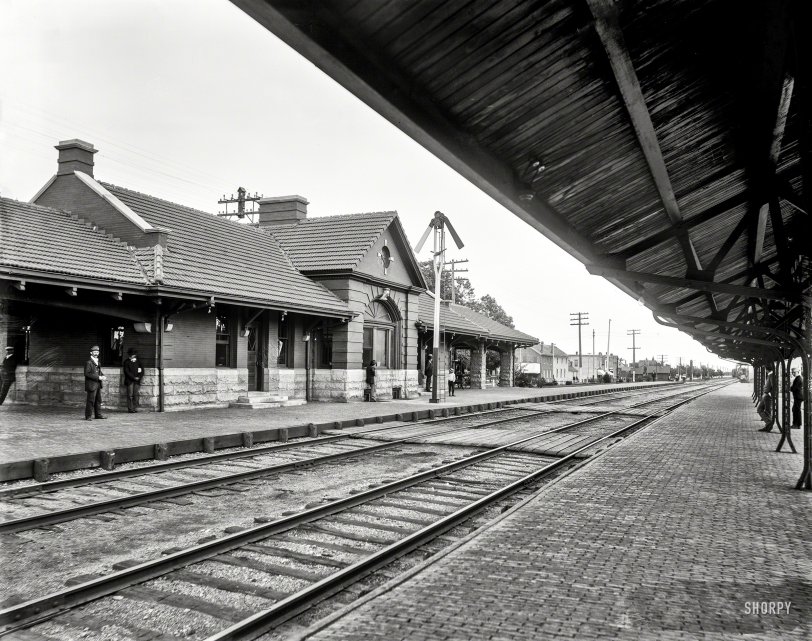


Framed or unframed, desk size to sofa size, printed by us in Arizona and Alabama since 2007. Explore now.
Shorpy is funded by you. Patreon contributors get an ad-free experience.
Learn more.

- Details, Details
- What's that building to the left of the tower?
- Coal Barges
- Bromo-Seltzer
- Inner harbor
- The Basin
- What a headache!
- Giant stepladder?
- Baldwin 62303
- Baldwin VO-1000
- Cold
- No expense spared
- Tough Guys
- Lost in Toyland
- And without gloves
- If I were a blindfolded time traveler
- Smoke Consumer Also Cooks
- Oh that stove!
- Possibly still there?
- What?!?
- $100 Reward
- Freeze Frame
- Texas Flyer wanted
- Just a Year Too Soon
- WWII -- Replacing men with women at the railroad crossing.
- Yes, Icing
- You kids drive me nuts!
- NOT An Easy Job
- I wonder
- Just add window boxes
Print Emporium
Elmhurst Depot: 1899

Circa 1899. "Chicago & North Western Railway station, Elmhurst, Ill." 8x10 inch dry plate glass negative, Detroit Publishing Company. View full size.
It iz....answer
signalman,
Thank you for the info! Makes sense now. I wonder if the 'thick' wire is just a thick ground or contains the two lines headed down to the station. I would think it as a ground as it is just too thick for two small lines.
Tie Plates
There are no tie plates to spread the load of the rails to the crossties (sleepers to our European friends). Some of the ties look the worse for wear because of this. According to Wikipedia, tie plates came into use around 1900, just about the time of this photo.
Another Left Handed Railroad
The Duluth Missabe & Northern, later incorporated into the Duluth Missabe & Iron Range, now part of the Canadian National, also considered itself to be a left hand railroad. On double track, trains ran on the left hand track, and all signals were placed to the left - even on single track. Some of these signals still remain.
It iz
It is indeed the tap for the circuits into the station; but a bit more than that. I can see five lines which can be opened - see the insulators on bars, so the wire comes in from (say) the east, runs into the station, comes back out, and heads west. That is, the wire is not continuous past the station, but both sides go into the station.
I would expect that the box contains primary lightning arrestors for each wire dropping into the station; secondary arrestors may be in the station.
With this arrangement, circuits can be patched from one wire position to another. Also remember that telegraph was the usual communication system at the time of this picture.
Left-Handed Train Operations on the C&NW Railway
In the deep background you can just make out two trains that illustrate one of the most peculiar features of the Chicago & North Western Railway, the fact that its trains operate on the left hand track, rather than the right hand track. This practice continues to this day, which makes the C&NW (now part of the Union Pacific system) the only left-handed railroad in the USA. The explanation for this unusual practice usually goes like this:
"The first component of what was to become the Chicago & North Western Railway was the little Galena and Chicago Union Railroad Company. Tracks were laid west from Chicago to Geneva, where the first station was to be built. The company built the station on the north side of the tracks where most of the people lived. This saved passengers the inconvenience of having to cross the tracks to go home.
When traffic required double tracks, the only place to lay new rails was south of the original single tracks. Since the stations were used primarily by passengers waiting to travel into Chicago, the company decided to run east-bound trains on the old track so riders would not have to cross the tracks to board—a dangerous process." (From Tom Hermes, "Why Does Our Train Run on the Wrong Track?" Winnetka [Illinois] Historical Society Gazette, Fall 1996, reprinted at www.winnetkahistory.org)
A Scratch-builder's Paradise
If you model train scenes, in any gauge, this picture is a veritable goldmine! Such wonderful details would keep the poor modeler busy for many a snowy evening. Positively stunning. Keep up the good work.
As a child I used to take the train there
... on Saturday mornings in the winter to play ice hockey at the YMCA several blocks away. Where did those fifty years go?
Whatizit
So my family and I have extensive telephony background, and personally I have that and railroad background, but still, what is the item on the telephone crossarm that looks to be rectangular, about 3 feet long with a pitched roof with one thick cable exiting the bottom? Is there a name for this and what is its purpose?
I agree there are lines going from the insulators into it, so it may be some sort of permanent tap for the stations telegraph/telephone. Even so, seems to be overdone for a simple splice.
























On Shorpy:
Today’s Top 5